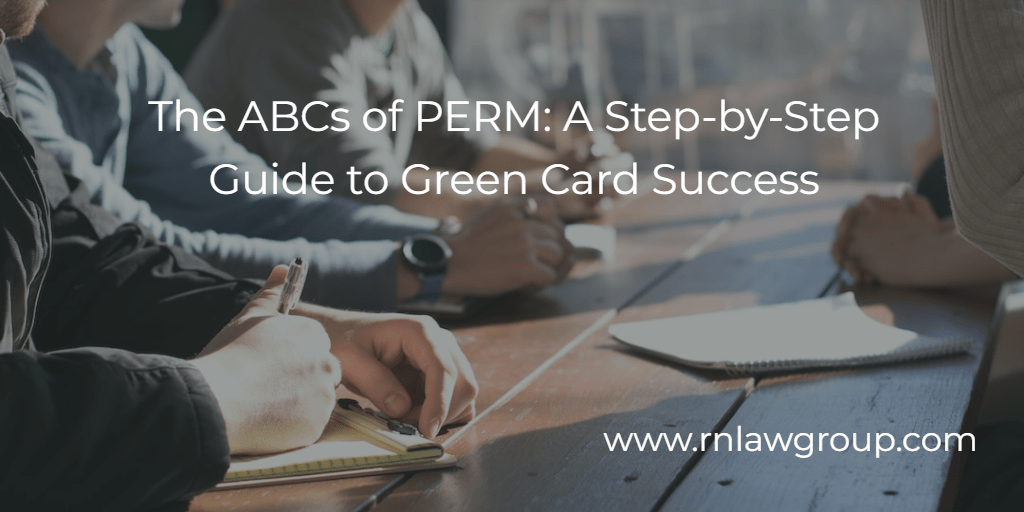
The ABCs of PERM: A Step-by-Step Guide to Green Card Success
There are three stages to the PERM based green card process:
- PERM Labor Certification – It is the first and typically most important step because it sets the stage for a successful green card process. This stage is handled by the Department of Labor.
- After the PERM is approved, the I-140 Immigrant Petition is submitted to USCIS. This is not the actual green card application, but a preliminary petition that establishes which employment based category the beneficiary will be assigned to. At this stage USCIS verifies the beneficiaries meets all the requirements set forth in the PERM application and determines the company’s ability to pay.
- The final step is the I-485 Adjustment of Status application which is filed with USCIS. We can only move forward with this final step once the beneficiary’s priority date is current, meaning a green card is immediately available to the beneficiary.
WHAT EXACTLY IS PERM?
PERM stands for Program Electronic Review Management, and it is the system used to obtain Labor Certification from the Department of Labor. Before an employer can obtain labor certification from DOL, the employer must first conduct recruitment to adequately test the U.S. labor market for able, willing, qualified, and available U.S. workers. This comes as a surprise to most employers who have not been through the PERM process before – the employer has an amazing employee who is perfect for the position, but DOL is telling them they must first recruit for that role before they can move forward with green card sponsorship.
We must keep in mind that it is DOL’s job to protect U.S. workers from being displaced and this is why PERM recruitment is necessary. If after recruitment has been completed and the employer is unable to find an able, willing, qualified, and available U.S. worker for the position, a PERM labor certification application can be filed with DOL on behalf of the beneficiary.
PERM STEP 1: DRAFTING JOB DESCRIPTION AND MINIMUM REQUIREMENTS
The development of a strong PERM application starts with the job description as the job description forms the core of the application. Employers need to accurately describe the position for which the beneficiary will be sponsored for – this includes the job title, job duties, the minimum education and experience requirements, and any other additional requirements for the position such as travel/relocation or licensing or certification requirements.
As the PERM position is actually for a future role that the beneficiary will hold once the green card is received, the job duties will need to be drafted in a way that will still be relevant in the future. This is especially important for those beneficiaries who may not receive a green card for many, many years due to the green card backlog.
The PERM job description can have an impact on the prevailing wage determination – the requirements of the job should not be overstated in an attempt to reduce the applicant pool. There is also the possibility that overstating the requirements for what is normal for the job might increase the wage determination beyond what the employer is willing to pay. A properly drafted PERM job description is especially important for employers who are frequent PERM filers. It is recommended that frequent PERM filers be consistent in their job descriptions for applications within the same occupation. Inconsistency between applications within the same occupation could lead Certifying Officers to determine that the requirements are being tailored for specific beneficiaries rather than reflecting the employer’s true actual minimum requirements for the position.
When establishing the minimum requirements for a role, ask the question, “What is the minimum amount of education and experience that is absolutely necessary to perform this job?” In other others, what are the baseline requirements that must be met? It is important to ensure that the beneficiary meets all the minimum requirements prior to the filing of the PERM application. While evidence does not need to be submitted to DOL, all qualifications will need to be listed on the PERM application. The evidence that documents the beneficiary’s qualifications, such as education documents and experience letters, will need to be provided to the USCIS during the I-140 stage of the process.
PERM STEP 2: PREVAILING WAGE DETERMINATION
Once the job details have been finalized, a Prevailing Wage determination request is submitted to the Department of Labor. The prevailing wage is considered the average wage paid to similarly employed workers in the area of intended employment and this is the wage that the employer will be required to offer. DOL believes that offering at least the prevailing wage amount to the beneficiary will ensure that wages and working conditions of other U.S. workers is not adversely affected.
DOL bases the prevailing wage on multiple factors including the occupational title, the job title, job duties, minimum requirements, the work location, and travel requirements, if any. As the PERM position is for future employment, the employer is not technically required to pay the offered wage until the time the beneficiary receives the green card. However, the employer must still be able to demonstrate that they have the ability to pay 100% of the prevailing wage (or offered wage, whichever is higher) from the time the PERM application is filed to when the beneficiary receives the green card. If the employer cannot demonstrate ability to pay, the I-140 petition will be denied.
Ability to pay can be demonstrated in 1 of 3 ways:
- Wages paid directly to the employee;
- The company’s net income; OR
- The company’s net assets.
PERM STEP 3: RECRUITMENT
Once the minimum requirements for the position have been set, it is time to start the recruitment process. As previously mentioned, the goal of the PERM process is to prove that there are no able, willing, qualified, or available U.S. workers to fill the position intended for the beneficiary and that no U.S. workers will be displaced by the hiring of the beneficiary.
During recruitment, there are certain mandatory advertisements that must be placed for both professional and non professional occupations. The employer must place 2 Sunday ads in the newspaper of general circulation in the area of intended employment, and the employer must place a Job Order with the State Workforce Agency that runs for a minimum of 30 days.
The employer must also post a Notice of Filing at a conspicuous place at the job location. The main purpose of the Notice of Filing is not to recruit, but to notify other employees of the company that a labor certification will be filed. This notice gives the employees the right to provide DOL any evidence regarding the application if necessary.
For professional positions, in addition to the mandatory recruitment efforts stated above, the employer must engage in at least 3 other forms of recruitment. DOL provides a list of 10 acceptable forms of recruitment that employers may choose from. As the recruitment process is exacting and time sensitive, it is recommended employers work with an experienced PERM attorney to ensure the process is properly handled.
Once recruitment has begun, employers may start to receive resumes from applicants. It is important to keep in mind that during this stage, employers are only allowed to reject U.S. workers for lawful job related reasons. Working with an experienced PERM attorney ensures procedure is followed carefully. There are a lot of nuances involved during this process, and failure to properly follow all the regulations could result in the denial of the PERM application.
PERM STEP 4: FILING THE PERM LABOR CERTIFICATION APPLICATION WITH DOL
If after the recruitment process has been completed and no able, willing, qualified, or available U.S. workers are found to fill the offered position, the employer can submit the PERM application with DOL. As of June 1, 2023, employers filing PERM applications must submit ETA-9089 through the Foreign Labor Application Gateway (FLAG) system. The actual PERM application’s structure and content has changed as part of the transition to the FLAG system as the new form aims to streamline the PERM process and increase efficiency in the Department of Labor’s review process. It is important to note that while the PERM form may have changed, the regulations of the PERM process have not.
When an employer submits the PERM application to DOL, the employer is attesting that all PERM regulations were followed – especially that U.S. workers who applied for the job opportunity were rejected only for lawful job related reasons. As there are no corrections or changes allowed to be made to the application once it is submitted, it is very important to make sure all information has been correctly entered. The Department of Labor does not easily overlook errors on the application, and even a minor typographical error can cause a denial of the PERM application. If changes are required, the original PERM application will need to be withdrawn and refiled if time permits.
Long DOL processing times are impacting those who are on temporary work visas, such as an H-1B. As the day the PERM application is filed with the Department of Labor establishes the beneficiary’s priority date and place in line for the green card, it is recommended that the PERM process is started as early as possible. Working with an attorney will ensure the process is successful from the very outset as mistakes made could require the entire process be started again causing even longer processing times and delays.
For over 25 years, Reddy Neumann Brown PC. has focused solely on U.S. employment-based immigration, and works with employers to establish best practices when navigating the PERM labor certification process. If you are in need of a U.S. work visa or permanent residency, speak with one of our immigration lawyers. Please contact us online, call our Houston business immigration office directly at 713-953-7787 or schedule a consultation.
By: Jessica Palarca
Jessica Palarca is an attorney in Reddy Neumann Brown’s PERM Labor Certification Department where she assists clients in the beginning stages of the green card process.

